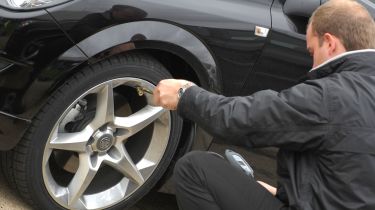How to check your car's tyre pressures
Tyre pressure affects safety, performance and fuel economy – we explain all

Keeping your tyres within the legal limit for tread depth may be something you are aware of and occasionally check, but what about tyre pressure? It isn’t just how much tread is left on a car’s tyres that dictates how well it will turn and stop, but the pressure within them. Underinflated or overinflated tyres will impact grip and fuel economy, so it’s vital to check the pressure of your tyres on a regular basis.
What does car tyre pressure mean?
Your car has a specific tyre pressure requirement, that depends on factors including the size of wheels and tyres fitted, and the car’s weight. While the car is driven, even new tyres will lose a small amount of pressure as it naturally escapes. This is why you should stay vigilant and make sure to check the pressures so they don’t drop too low. As a rule of thumb, it’s a good idea to do this every time you fill up with fuel, and before every long drive – especially if it includes the motorway.
The two most common units of pressure commonly found on tyre pumps are pounds per square inch (or PSI) and bar. You’ll find both of these quoted together in every car’s handbook, showing the maximum safe pressure your tyres should be inflated to. There may be a sticker on the car too, inside the driver’s door slam or near the fuel filler cap to remind you.
You’ll find air pressures are given for various loadings (two occupants, four occupants or four occupants and luggage). The front tyres are often at a higher pressure than the rears because the weight is usually at the front of the car (because of the engine).
Tyre pressure and safety
Be sure to check that you don’t over- or under-inflate your tyres when you top them up, as this will result in the contact patch of the tyre being deformed, resulting in uneven wear.
Too much air will cause the centre of the tyre to protrude resulting in a smaller contact patch wearing the centre of the tread.
The less air is inside the tyre, the larger the contact patch. However, because of the way a tyre is constructed, it’s not the centre that’s in contact, but the edges. Again, grip is reduced.
Driving with incorrectly inflated tyres can also lead to tyre failure, placing strain on the edges or risking a blowout. It’ll also increase tyre wear.
Tyre wear and fuel economy
Underinflated tyres are a drag – quite literally. There’s more rubber in contact with the road, meaning the engine has to work harder to overcome the extra drag and resistance it causes. This increases fuel consumption. So keeping your tyres properly inflated will increase tyre life, reduce fuel consumption and save you money.
How often should I check my tyres?
Monthly is essential, but if you can check them once a week you’ll be doing yourself a big favour. If you notice that you are regularly losing pressure from one or more tyres faster than you expect then visit a tyre shop, you may have a slow puncture.
While you’re at it, check for damage, such as tears and bulges and objects sticking in the tyre that could be causing a slow puncture. Check the tread depth, too.
How do I check my tyres?
A tyre fitter is the best person to check your tyres but you can always ask them to show you how it’s done if you’re unsure.
To do it yourself, the first thing you’ll need is a good tyre-pressure gauge from an accessory shop. It’s easier than visiting a garage forecourt every time.
Locate the tyre valve sticking out of the wheel rim and unscrew the cap. Push on the tyre pressure gauge and check the pressure readout with your car manufacturer’s recommended figure.
If there’s a discrepancy, remove the gauge and pump up the tyre using a foot pump (cheap) or a powered one (about £30). This plugs into the car’s 12v power socket. Check the pump’s manual for operating instructions.
Using a garage forecourt pump
If you don’t have a tyre pump, find a garage forecourt that does. In addition to the pressure display (in bar and PSI), it may have four buttons. Two will show plus and minus, indicating fill or release and enabling you to set the pressure, which you’ll find on the car or in the handbook.
A third button will give a rapid fill for when your tyre is very low on air. Be careful not to use it if your tyre is reasonably full already. The fourth button will allow you to choose the pressure measurement.
Since it’ll most likely be a coin-operated pump, it makes sense to save time by removing the valve caps first before starting the machine. All done, insert your coin, and attach the pressure hose to the first tyre. It’ll check the pressure you set and if air is required, will supply it. When it reaches the pre-set pressure, it’ll beep and stop pumping.
Repeat the process on the remaining tyres, including the spare. When you’ve finished, carefully allow the pump hose to return to its housing rather than letting it fly back when it could damage your car or strike someone. Screw the valve caps back on and you’re finished.
And finally…
All cars built since 2014 must have a tyre-pressure monitoring system. While it’s very useful, you shouldn’t rely on it, but do your own checks, too, as well as check the condition of the tyres. Checking your tyres should be like checking your car’s oil level (if you don’t do that, you should!). Doing so could save your life, as well as save you money.
If you want to learn more about tyres why not check out our guide on tyre labels, and tyre tread depths.
Most Popular
Tips & advice

Car dashboard warning lights: what does each symbol mean?

Electric car charging stations: public networks, charger types, apps and maps






